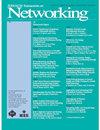Cross-Technology Federated Matching for Age of Information Minimization in Heterogeneous IoT
IF 3.6
3区 计算机科学
Q2 COMPUTER SCIENCE, HARDWARE & ARCHITECTURE
引用次数: 0
Abstract
Heterogeneous Internet of Things (IoT) networks, which operate using various protocols and spectrum bands like WiFi, Bluetooth, Zigbee, and LoRa, bring many opportunities to collaborate and achieve timely data collection. However, several challenges must be addressed due to heterogeneous data patterns, coverage, spectrum bands, and mobility. This paper introduces a cross-technology IoT network architecture design that facilitates collaboration between service providers (SPs) to share their spectrum bands and offload computing tasks from heterogeneous IoT devices using multi-protocol mobile gateways (M-MGs). The objective is to minimize the age of information (AoI) and energy consumption by jointly optimizing collaboration between M-MGs and SPs for bandwidth allocation, relaying, and cross-technology data scheduling. A pricing mechanism is presented to incentivize different levels of collaboration and matching between M-MGs and SPs. Given the uncertainty due to mobility and task requests, we design a cross-technology federated matching algorithm (CT-Fed-Match) based on a multi-agent actor-critic approach in which M-MGs and SPs learn their strategies in a distributed manner. Furthermore, we incorporate federated learning to enhance the convergence of the learning process. The numerical results demonstrate that our CT-Fed-Match-RC algorithm with cross-technology and relaying collaboration reduces the AoI by 30 times and collects 8 times more packets than existing approaches.跨技术联盟匹配,实现异构物联网中的信息时代最小化
异构物联网(IoT)网络使用WiFi、蓝牙、Zigbee和LoRa等各种协议和频段运行,为协作和实现及时数据收集带来了许多机会。然而,由于异构数据模式、覆盖范围、频谱带和移动性,必须解决一些挑战。本文介绍了一种跨技术的物联网网络架构设计,该设计促进了服务提供商(sp)之间的协作,以共享其频谱带,并使用多协议移动网关(m - mg)从异构物联网设备中卸载计算任务。目标是通过共同优化m - mg和sp之间在带宽分配、中继和跨技术数据调度方面的协作,最大限度地减少信息年龄(AoI)和能源消耗。提出了一种定价机制来激励m - mg和sp之间不同程度的合作和匹配。考虑到移动性和任务请求所带来的不确定性,我们设计了一种基于多智能体参与者批评方法的跨技术联邦匹配算法(CT-Fed-Match),其中m - mg和sp以分布式方式学习他们的策略。此外,我们还结合了联邦学习来增强学习过程的收敛性。数值结果表明,采用跨技术和中继协作的CT-Fed-Match-RC算法比现有方法减少了30倍的AoI,收集的数据包数量增加了8倍。
本文章由计算机程序翻译,如有差异,请以英文原文为准。
求助全文
约1分钟内获得全文
求助全文
来源期刊

IEEE/ACM Transactions on Networking
工程技术-电信学
CiteScore
8.20
自引率
5.40%
发文量
246
审稿时长
4-8 weeks
期刊介绍:
The IEEE/ACM Transactions on Networking’s high-level objective is to publish high-quality, original research results derived from theoretical or experimental exploration of the area of communication/computer networking, covering all sorts of information transport networks over all sorts of physical layer technologies, both wireline (all kinds of guided media: e.g., copper, optical) and wireless (e.g., radio-frequency, acoustic (e.g., underwater), infra-red), or hybrids of these. The journal welcomes applied contributions reporting on novel experiences and experiments with actual systems.
 求助内容:
求助内容: 应助结果提醒方式:
应助结果提醒方式:


